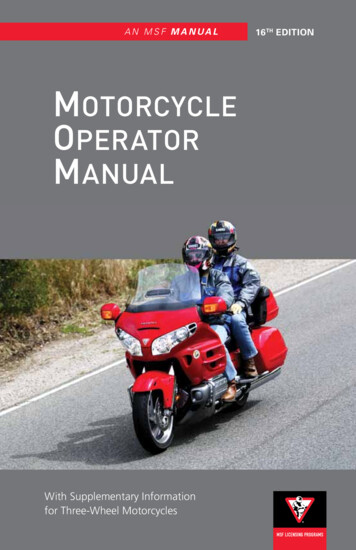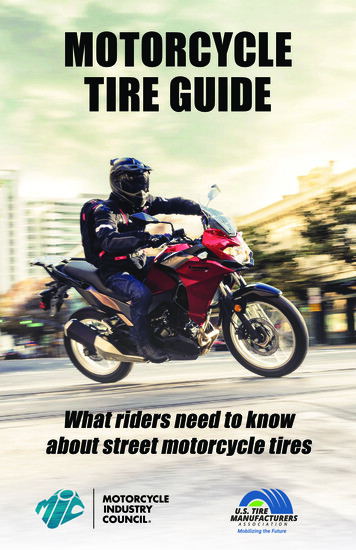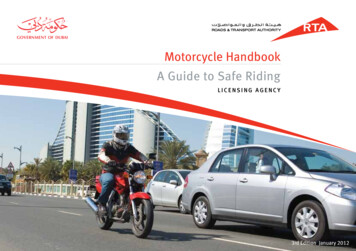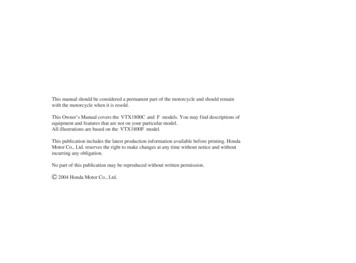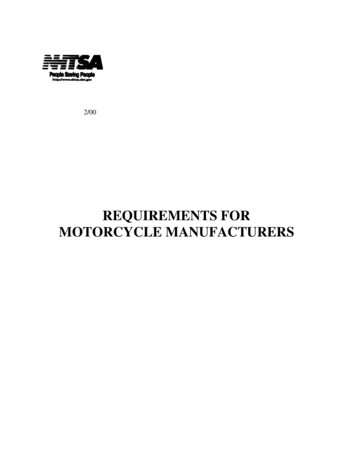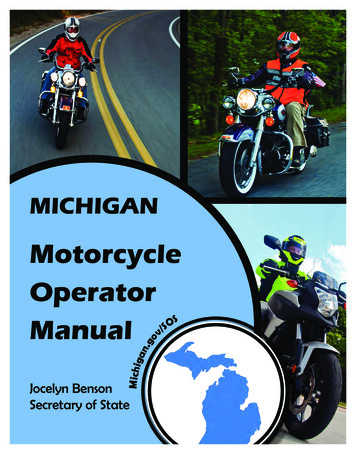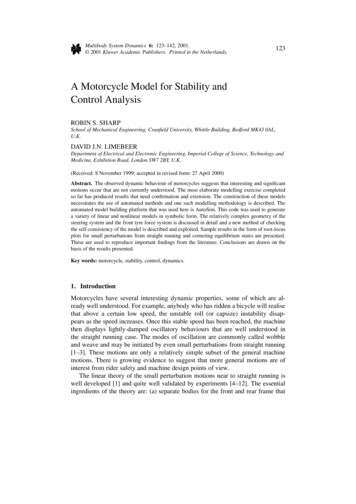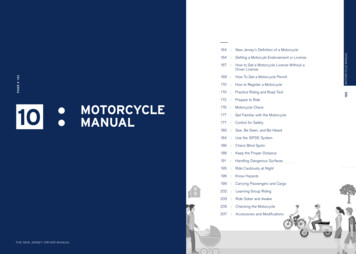
Transcription
THE NEW JERSEY DRIVER MANUALNew Jersey’s Definition of a Motorcycle164:Getting a Motorcyle Endorsement or License167:How to Get a Motorcycle License Without aDriver License169:How To Get a Motorcycle Permit170:How to Register a Motorcycle170:Practice Riding and Road Test172:Prepare to Ride176:Motorcycle Check177:Get Familiar with the Motorcycle177:Control for Safety180:See, Be Seen, and Be Heard184:Use the SIPDE System186:Check Blind Spots188:Keep the Proper Distance191:Handling Dangerous Surfaces195:Ride Cautiously at Night196:Know Hazards199:Carrying Passengers and Cargo202:Learning Group Riding203:Ride Sober and Awake205:Checking the Motorcycle207:Accessories and ModificationsMotorcycle Manual:163PA G E # 16 210MOTORCYCLEMANUAL164
The motor power can be part of the vehicle or attached. The vehicle must have asaddle or seat for the driver to sit astride or upon, or a platform on which to stand.Getting a Motorcyle Endorsementor LicenseEvery New Jersey resident who operates a motorcycle or trike must have a NewJersey motorcycle driver license or a motorcycle endorsement on an existing NewJersey basic or commercial license. Two exceptions exist:Basic auto license holders can operate a low-speed motorcycle without anyendorsement or separate motorcycle license. Low-speed motorcycles are less than50cc or have a motor rated at no more than 1.5 brake horsepower with a maximumspeed of no more than 35 mph on a flat surface. Low-speed motorcycles may notbe operated on any state toll road, limited-access highway or any public road witha posted speed limit greater than 35 miles per hour. (N.J.S.A. 39:3-76.11)Note: Anyone who takes a road test at MVC on a motorcycle that is 231cc orless is restricted to riding only a 500cc or less motorcycle (M endorsement orClass E motorcycle-only license with restriction). If the road test is taken on amotorcycle that is over 231cc, there will be no restriction with the M endorsementor motorcycle-only license. Anyone who successfully completes a MotorcycleSafety Education Program (MSEP) course is exempt from this motorcycle sizerequirement and will not be restricted. Riders who are restricted to a motorcyclethat is 500cc or less will have a restriction “5” noted on their license and will berequired to carry an MVC-issued restriction card while operating the motorcycle.1. The operator of a three-wheeled motor vehicle, equipped with a singlecab that has a glazing around the occupant, seats similar to thoseof a passenger vehicle or truck, seat belts or automotive steering, isnot required to have a motorcycle endorsement added to their basicautomobile driver license, and is not required to wear a helmet.HOW TO ADD A MOTORCYCLE ENDORSEMENT TO YOUR DRIVERLICENSE2. The operator of a low-speed motorcycle.ENROLL IN A BASIC RIDER COURSEApplicants who already have a valid New Jersey basic or commercial driver licensemay qualify for test of knowledge and motorcycle road test waivers by taking anapproved NJ Motorcycle Safety Education Program (MSEP) Basic Rider Course(BRC). For details, please visit www.njridesafe.org.Some applicants may not qualify for waivers, including those in the GraduatedDriver License (GDL) Program. Contact the MVC for details, at (609) 292-6500.Note: Anyone under the age of 18 is required to take the Motorcycle Safety Education Program Basic Rider Course before receiving a motorcycle endorsement.Note: A valid basic driver license is required to operate an autocycle. A motorcyclelicense or endorsement is not required.Enroll in a basic rider course, (or a 3-wheel basic rider course for trikes), or beginby purchasing a permit at a local motor vehicle agency.Step 1: Take Basic Rider Course Register with an approved motorcycle training provider. Take motorcycle training course.Step 2: Get Course Completion Documents 100% participation required. Must successfully complete course. Will receive a stamped waiver form and a completion card.Note: You must add a motorcycle endorsement to your license before you beginriding after completing the course. No motorcycle permit required to take a ridercourse.THE NEW JERSEY DRIVER MANUALWWW.NJMVC.GOVMotorcycle ManualAccording to New Jersey law, the classification of motorcycles includes motorcycles,autocycles, motor bikes, bicycles with a motor attached, and all other motoroperated vehicles of the bicycle or tricycle (trike) type, but not motorized bicycles.LOW-SPEED MOTORCYCLES165New Jersey’s Definition ofa Motorcycle
How to Get a Motorcycle LicenseWithout a Driver License Must apply for a motorcycle permit.Always Begin By Purchasing A Permit At A Local Motor Vehicle Agency Must be at least 17 year old; parent/guardian consent required underage 18.ENROLL IN A BASIC RIDER COURSE Must pass vision test. Must pay required fee.APPLY WITHOUT A BASIC RIDER COURSEMotorcycle Permit Required First. Must Be At Least Age 18 To Take The MVCRoad Test.Step 1: Get A Motorcycle Examination Permit Apply for a motorcycle permit at a local motor vehicle agency. Must be at least 17 years old; parent/guardian consent required underage 18. Must pass MVC’s knowledge and vision tests. Make road test appointment date. Must pay required fee.Step 2: Practice Ride Must practice ride for at least 20 days. Must observe motorcycle permit riding restrictions.Step 3: Take Motorcycle Road Test At MVC Test Site Must bring your own motorcycle (registered and insured), helmet, andeye protection. Must pass road test (Must be at least age 18).Step 4: Get Motorcycle Endorsement Must pay required fee.Motorcycle Permit Required First. Anyone Under The Age Of 18 Is Required ToTake The Motorcycle Safety Education Basic Rider Course.Step 1: Get A Motorcycle Examination Permit Apply for a motorcycle permit at a local motor vehicle agency. Must be at least 17 years old; parent/guardian consent required underage 18. Must pass MVC’s knowledge and vision tests. Must pay required fee.Step 2: Practice Ride Must practice ride for at least 6 months if under the age of 21 or 3months if over 21 without any suspensions or postponements. Must observe motorcycle permit riding restrictions.Step 3: Take Basic Rider Course With An ApprovedMotorcycle Training Provider Register with a motorcycle training provider. Take a motorcycle training course.(Steps 2 and 3 can be interchanged. You must have your practice riding time inbefore getting your motorcycle license.)Step 4: Get Course Completion Documents 100% participation required. Must successfully complete course. Will receive a course completion card only (not a road test waiver).THE NEW JERSEY DRIVER MANUALWWW.NJMVC.GOVMotorcycle ManualMust bring course completion documents to a driver testing center andprove your identity by passing 6 Point ID Verification.167 Step 3: Get Motorcycle Endorsement
Must bring your own motorcycle (registered and insured), helmet,and eye protection.Step 6: Get Probationary Motorcycle License (Class E) Must bring your own motorcycle (registered and insured), helmet,and eye protection.Step 4: Get Probationary Motorcycle License (Class E) Must pass MVC’s road test. Must pass road test (Must be at least age 18). Must pay required fee. Must pay required fee.Step 7: Probationary Riding PrivilegesStep 5: Probationary Riding Privileges Must ride for at least one year. Must ride for at least one year. Must follow probationary driver license restrictions. Must follow probationary driver license restrictions.Step 8: Get Unrestricted Motorcycle LicenseStep 6: Get Unrestricted Motorcycle License Must be at least 18 years old. Must be at least 18 years old. Must have completed one year of riding. Must have completed one year riding. Must pay required fee. Must pay required fee.APPLY WITHOUT A BASIC RIDER COURSEMotorcycle Permit Required First. Must Be At Least Age 18 To Take The MVCRoad Test.Step 1: Get A Motorcycle Examination Permit Apply for a motorcycle permit at a local motor vehicle agency. Must be at least 17 years old; parent/guardian consent required underage 18.How To Get a Motorcycle Permit You must be at least 17 years old; parent/guardian consent requiredunder age 18. Complete a motorcycle permit application from an MVC Agency. Pass the 6 Point ID Verification. Pay 5 permit fee.Pass the knowledge and vision tests to validate your permit.Study by reading the Driver Manual and Motorcycle Manual. Must pass MVC’s knowledge and vision tests. Must pay required fee. Step 2: Practice Ride Must practice ride for at least 6 months if under the age of 21 or 3months if over age 21 without any suspensions or postponements. Must observe motorcycle permit riding restrictions.MOTORCYCLE PERMIT RIDING RESTRICTIONSThe holder of a motorcycle examination permit is prohibited from: Operating a motorcycle from one-half hour after sunset to one-halfhour before sunrise.THE NEW JERSEY DRIVER MANUALWWW.NJMVC.GOVMotorcycle Manual Step 3: Take Motorcycle Road Test At MVC Test Site169Step 5: Take Motorcycle Road Test At MVC Test Site
Riding on any state toll road or limited-access highway.PRACTICING WITH YOUR PERMIT1. Turning and Stopping: Tests an applicant’s ability to control the motorcyclewhile turning and stopping. The examiner will evaluate an applicant’s ability tostay within the path of the turn without putting a foot down, and to stop safely in apainted stop box without putting a foot down or skidding the vehicle.You must practice with a permit for at least 20 days before being eligible to takethe road test. A motorcycle examination permit holder is no longer required to havean accompanying rider.Motorcycle ManualCarrying passengers.Stop with front tire in boxHow to Register a MotorcycleNew Jersey’s annual motorcycle registration fee is 65. To register a motorcycle,bring a valid insurance card and title to a motor vehicle agency. One license platemust be displayed on the rear of the motorcycle at all times.Qualified motorcyclists can obtain a Person with a Disability license plate thatallows them to park in specially marked parking spaces. To obtain an applicationonline visit www.njmvc.gov or request one by calling (609) 292-6500. Mailcompleted application to:MVC Special Plate UnitP.O. Box 015Trenton, NJ 08666-0015Sharp left turnStart2. Cone Weave (U-Turn): Tests an applicant’s ability to control the motorcycle atlow speed while weaving through cones and making a U-Turn in a designated area.StartOver 500ccRiders should keep in mind that it is their responsibility to make sure theirmotorcycles are free from mechanical defects and are operating properly.Although motorcycles are no longer required to be inspected in New Jersey, lawenforcement may still perform a roadside inspection and issue citations to cyclistsfor equipment out of compliance or failure to make repairs.Practice Riding and Road TestNote: The following section does not refer to those testing on a trike. The triketest is similar to the basic auto road test.The MVC recommends that all applicants practice all riding skills. However,emphasis is placed on the following skills:500cc and underRight U-turnThe examiner will evaluate an applicant’s ability to stay within the path of travelwithout touching lines or cones, and without putting a foot down. Cones are 12feet apart with a two-foot offset.3. Braking: Tests an applicant’s ability to safely brake quickly. An applicant will beevaluated on stopping distance in relation to speed of travel.THE NEW JERSEY DRIVER MANUALWWW.NJMVC.GOV171
GEAR CHECKObstacle turnA good rider wears:Start Approved eye and face protection. Note: An applicant who stalls the motorcycle during the skills test will fail.Prepare to RideThe helmet is the single most important piece of equipment riders must wear. Oneof every five reported motorcycle crashes involves head or neck injuries. A helmetimproves survival in crashes. Make sure the approved helmet is fastened securely.A properly fitting, approved helmet can increase rider comfort and reduce fatigue.1734. Obstacle Swerve: Tests an applicant’s ability to swerve the motorcycle quicklyto avoid an obstacle. An applicant will be evaluated on the ability to stay within thepath of travel and turn quickly without touching a boundary line.Protective clothing.HELMET USEHelmets are required by law for motorcycle operators and riders in New Jersey.Operators who carry passengers who do not wear helmets can be fined.Consider these additional facts:Properly preparing for a trip is critical to safety. Before riding a motorcycle, checkall gear and the motorcycle itself. If the motorcycle is borrowed, determine if anyoperational differences exist.Try the horn and controls before you startClean, adjust mirrorsHeadlights An approved helmet ensures adequate peripheral vision for riders. Astudy of more than 900 motorcycle crashes, in which 40 percent of theriders wore helmets, found no cases where a helmet impaired a rider’svision or masked danger. Most crashes happen on short trips – less than five miles long – shortlyafter starting. Even low-speed crashes can be fatal. In fact, most occur at speedsslower than 30 mph. At these speeds, helmets can cut the number andseverity of head injuries by half.Check gas and oil levelsRegardless of speed, riders without helmets are three times more likely to die fromhead injuries than riders wearing helmets at the time of the crash.HELMET SELECTIONApproved helmets come in three types: one-half, three-quarter and full face. Eachmust:TiresCondition, Tread Depth, InflationAdjusted and lubricated drive chain Meet U.S. Department of Transportation (USDOT) Federal MotorVehicle Standard (FMVSS) 218. Look for the DOT symbol on theTHE NEW JERSEY DRIVER MANUALMotorcycle Manual An approved U.S. Department of Transportation helmet.WWW.NJMVC.GOV
age. For maximum protection and comfort, replace equipment regularly.FULL FACEONE-HALFTHREE-QUARTERBe scratch-free. Be made of shatterproof material. Give a clear view to either side. Fasten securely. Allow air to pass through, so it will not fog.outside back of the helmet. Then, look for a label inside the helmetwith the manufacturer’s name, month, and year of manufacture,construction materials, model, size, and other important information. Be equipped with a chinstrap and have at least four square inches ofred, amber, or white reflectorized tape on each side. Lack obvious defects, such as cracks, loose padding or frayed straps.Note: Not all helmet damage is obvious. To ensure safety, do not buy a usedhelmet.When riding, keep the helmet securely fastened at all times. A loosened helmet islikely to fall off during a crash.EYE AND FACE PROTECTIONMotorcycle operators are required to wear approved goggles or a face shield whenoperating a motorcycle, unless the motorcycle is equipped with a windscreen.(N.J.S.A. 39:3-76.8, 76.9) A full-face helmet offers riders the most protection.A plastic face shield does protect a rider’s face from wind, dust, dirt, rain, insects,and debris. Regardless, attention should be on the road – not on these potentialproblems. Choose equipment that is not distracting, so that your complete attentionis on the road. Goggles can also protect a rider’s eyes from wind, dust, dirt, rain,insects, and debris, but do not protect the rest of a rider’s face – but a face shielddoes. Most windshields will not protect eyes from wind; neither will eyeglasses orsunglasses. Glasses will not keep eyes from watering and might blow off whileriding. Face shields and goggles must meet U.S. Department of Transportationand New Jersey standards, and should have the ANSI label. Because they areplastic, face shields and goggles will develop scratches and become brittle with Allow enough room for eye glasses or sunglasses, if needed. Tinted eye protection should not be worn at night or any other timewhen little light is available.CLOTHINGClothing helps protect riders in crashes and in other situations. Jackets and pantsshould cover arms and legs completely, while still providing comfort. Both shouldfit snugly enough that there is no flapping in the wind and loosely enough to let therider move freely.Bright, reflective helmets and clothing help others see a motorcyclist.Leather offers the most protection, but sturdy, synthetic material also providesprotection. Wear a jacket even in warm weather. Many motorcycle jackets aredesigned to protect without over-heating, even on warm days.Boots and shoes should be high enough to cover ankles and sturdy enough toprovide support. Soles should be made of a hard, durable material. Heels shouldbe short enough not to catch on rough surfaces. Boot straps and shoelaces shouldbe tucked in.Full-finger leather or other motorcycle gloves are also important as they provide agood grip on controls, while helping to protect hands during a crash.In cold or wet weather, clothes should keep riders warm and dry, as well asprotect riders from injury. Safely controlling a motorcycle with numb arms is nearlyimpossible. Riding for long periods in the cold weather can cause severe chill,fatigue, and hypothermia. A winter jacket should be wind resistant and fit snugly atTHE NEW JERSEY DRIVER MANUALWWW.NJMVC.GOV175 Motorcycle ManualEffective eye or face protection must:
the neck, wrists, and waist. Rain suits should be sized so they are easily removedand put on, as well as designed for riding. Otherwise, these suits can tear apartor balloon up at high speeds. Some gloves are made to keep wind or rain fromtraveling up sleeves.Chain. Make sure the drive chain is properly adjusted and lubricated. Check themotorcycle owner’s manual for information regarding chain adjustment.Motorcycle CheckMirrors. Clean and adjust mirrors before riding. It is difficult and dangerous toadjust a mirror while riding. Swing both mirrors far enough outward to show abouthalf the lane behind and as much as possible of the lane to the side.Tires. Keep tires in good condition. Check the tire pressure using a gauge. A tiremay be underinflated without a noticeable change in appearance. Motorcycles donot handle properly if the air pressure is too low or too high. Check the owner’smanual for the right amount of air.Tire Tread. Worn or uneven tread can make the motorcycle hard to handle,particularly on wet pavement.Get Familiar with the MotorcycleBe completely familiar with the motorcycle before riding it. If the motorcycle isborrowed: Check everything. Learn where all controls are; turn signals, horn, headlight switch, fuelcontrol valve, and motor cut-off switch. Be able to find and operatethem without having to look.Controls. Make sure the controls work smoothly. The throttle should snap backwhen released. Check controls. Learn the gear pattern. Work the throttle, clutch, andbrakes a few times before riding.Cables. Check for kinks or broken strands. If a cable breaks while riding, themotorcycle could become difficult to control and a crash could result. Ride very cautiously until learning how the motorcycle handles. Forinstance, take turns slowly and allow for extra stopping distance.Rims/Spokes. Check for bent, loose or damaged rims or spokes.Damage. Check for cuts or objects stuck to the tread. Also, check the sidewallsfor cracks. A blowout on a motorcycle can be extremely dangerous.Lights. Make sure all lights work. Keep them clean.Turn Signal. Check all four turn signal lights. Make sure they flash when on andare bright (easily seen).Headlight. Check the headlight. In daytime, pass a hand in front of the beamto make sure it works. At night, try the dimmer to make sure both high and lowbeams work.Control for SafetyTo learn how to control direction, speed, and balance, all riders should practice.This manual suggests ways to keep control of the motorcycle and avoid crashes.BODY POSITIONTo control a motorcycle well, riders must be in the proper position.Tail and Brake Light. Try each of the brake controls and make sure that each oneflashes the brake light.THE NEW JERSEY DRIVER MANUALWWW.NJMVC.GOVMotorcycle ManualGas and Oil. Check gas and oil levels before riding. Running out of gas isinconvenient. It can also be dangerous as it makes leaving the road difficult. Lackof oil can seize an engine, causing the rear wheel to lock and loss of control.177If something is wrong with the motorcycle, it is important to find out before enteringtraffic. Check these things before every ride:Horn. Ensure the horn works.
Light switch (high/low)Engine cut-off switchElectric start buttonSpeedometer & OdometerSlow Down. Reduce speed before a turn. Keep speed down until completing theturn.Look. Use head turns for directional control and to look through the turn.Turn-signal switchHorn buttonNew riders often try to take curves or turns too fast, causing panic and loss ofcontrol. Braking too hard, which may cause a skid or loss of control, can also occur.Riders must learn to judge how fast a curve may safely be taken. Approach allturns with caution. When turning, use the following steps for better control:ThrottleTachometer (if equipped)Lean. To turn, the motorcycle must lean. To lean the motorcycle, push on thehandgrip in the direction of the turn. Maintain steady speed or accelerate gradually.Avoid decelerating in the turn. Higher speeds and/or tighter turns require morelean. In normal turns, the rider and motorcycle should lean together. In slow, tightturns, lean the motorcycle only and keep your body straight.BRAKING/STOPPINGClutch leverFront brake leverIgnition key(varies)Gear-change pedalRear brake pedalKick starter(if equipped)Motorcycles have two brakes. Both are needed to stop effectively and safely. Thefront brake provides about three-quarters of the stopping power. Front wheel locksrelease the lever until the tire regains traction. If the rear wheel locks, do notrelease it. Keep it locked until the motorcycle comes to a stop.When braking, remember: Practice using the front brake correctly. Braking is an activity thatrequires continuous practice for maximum proficiency. When slowing down or stopping, always use both brakes. This ensuresriders have enough skill to use the front brake properly when needed. Apply both brakes at the same time. Do not apply the rear brake first.Knees. Keep knees against the gas tank to keep balance as the motorcycle turns.SHIFTINGFeet. Keep feet firmly on the foot pegs. Firm footing helps keep balance. Do notdrag feet along the ground. Feet catching something on the ground can cause lossof control. Keep feet near the controls to get to them quickly, if necessary. Also,keep toes pointed up to keep them from getting caught in between the road andthe foot peg.There is more to shifting than getting the motorcycle to accelerate smoothly.Instability can occur if the gears are used incorrectly when downshifting, turning orstarting from a standstill on a hill. Change gears to match the engine speed withthe road speed.THE NEW JERSEY DRIVER MANUALWWW.NJMVC.GOVMotorcycle ManualHands. Hold handle grips firmly. This helps riders keep a solid grip if the motorcyclebounces. A rider’s wrist should be down. This helps keep a rider from using toomuch throttle.TURNING179Posture. Keep back straight, and head and eyes up. Arms should be relaxed andslightly bent.
It is important to shift down through gears for the appropriate slow down or stop.This ensures riders always have enough power to accelerate quickly if needed.Travel at the proper speed to shift into a lower gear. Motorcycles may lurch, andthe gear wheel may lock up, if downshifting is performed at too fast a speed or theclutch is released abruptly. Remember:Bright, reflective helmets and clothing help others see the motorcycle. Upper bodyclothing should be brightly colored orange, yellow, red or green. Fluorescent colorsare sufficient in bright daylight. At night, reflective or retro-reflective clothing isbest.Riding downhill. Motorcycles tend to pick up speed on a downgrade.Shifting into first gear. On many motorcycles, the speed range for first gear isvery low. Under these conditions, use the brakes to slow down enough to shiftsafely.GOING UPHILLIt is more difficult to get the motorcycle moving on an upgrade than it is on flatground. There is always a danger of rolling backward and into another vehicle.Remember: Use the front brake to hold the motorcycle while starting the engineand shifting into first gear. Change to the foot brake to hold the motorcycle while operating thethrottle with the right hand. For more power, open the throttle a little bit. Release the clutch gradually. The front wheel may come off the groundor the engine may stop, or both, if it is released too quickly. Release the foot brake when the engine begins to slow down and themotorcycle begins to move forward.Reflective materials are passive and do not change their brightness. Retroreflective materials change brightness with surrounding light sources. They greatlyincrease the visibility of objects at night or during inclement weather.HEADLIGHTThe best way to help others see you is to keep headlights on at all times. During theday, a motorcycle with lights off is twice as likely to go unnoticed. The headlight inmany later-model motorcycles comes on automatically.SIGNALSSignals communicate intentions to other road users.Turn SignalsUse turn signals to: Clearly indicate lane changes and other riding maneuvers. Become easier to see. Other motorists can easily see turn signals.The required signal may be given “by means of the hand and arm or by anapproved mechanical or electrical signal device.” “A signal of intention to turn rightor left when required shall be given continuously during not less than the last 100feet traveled by the vehicle before turning.” (NJSA 39:4-126)See, Be Seen, and Be HeardNote: Turn off turn signals after the turn or lane change is made. If not, othermotorists might be confused about a rider’s intentions.In crashes with motorcyclists, other motorists often say that they never saw themotorcycle. From ahead or from behind, a motorcycle’s outline is small, and it iseasier for other motorists to misjudge distance and speed. However, there areways to make riders and motorcycles more noticeable.BRAKE LIGHTHelp others see the motorcycle by tapping the foot brake lightly before slowingdown. This action will flash the brake light. It is very important to signal others byTHE NEW JERSEY DRIVER MANUALWWW.NJMVC.GOVMotorcycle ManualCLOTHING181DOWNSHIFTING
flashing the brake light when: Slowing down where others may not expect it. (For example, beforeslowing down to the turn in the middle of a block.) When being followed closely, flash the brake light before slowing down.(This cannot be done, however, in an emergency situation.)Visible areaMotorcycle ManualSlowing down more quickly than might be expected. (For example,before making a turn from a high-speed highway.)HORNUse the horn to get the attention of other motorists, but do not rely solely on it. Usethe horn when someone is in the driver’s seat of a vehicle parked on the street,riding a bicycle, or walking in the street, and may pull into traffic. In an emergency,use the horn and be ready to slow down or turn away from danger.The two biggest dangers are: Oncoming vehicles turning left. Vehicles on side streets pulling into traffic. Never count on “eye contact”as a sign that a motorist is aware and will yield the right-of-way. All toooften, a motorist looks right at a motorcycle and still does not see it.ROAD POSITIONCENTER POSITIONIt is not true that riding in the center of a lane is dangerous because of the greasestrip residue left by other vehicles. Still, it is best to ride slightly to the left or theright of center. Unless the road is wet with rain, traction on most grease strips isthe same as the rest of the pavement. However, big grease buildups found at busyintersections or tollbooths should be avoided.INTERSECTIONSEnter the intersection with a space cushion on either side that allows evasive actionif necessary. Approach an intersection with the best view of oncoming traffic.Motorists have very little choice about positioning in travel lanes. However, eachmarked lane provides three possible travel paths to motorcyclists. To be seenmost clearly, ride in the portion of the lane where it is most likely a motorist cansee a motorcycle. When behind a vehicle, ride where the motorist can see themotorcycle in the rearview mirror. Be sure you can see the rearview mirror of thevehicle in front of you if you can see the rearview mirror in front of you, it is morelikely the driver can see you.BLIND AREABLIND SPOTSWhen alongside a vehicle, speed up and get by quickly or drop back.BLIND AREATHE NEW JERSEY DRIVER MANUALWWW.NJMVC.GOV183
Use the SIPDE SystemPedestrians and animals. They are characterized by unpredictability and quickmovement.Nothing can guarantee that other motorists will see a motorcycle. A good rider isalways looking to stay out of trouble.Experienced riders use a system known as SIPDE, an acronym for a process usedto make judgments and take action in traffic. SIPDE Scan, Identify, Predict,Decide, Execute.Here is a closer look at each of these steps.Stationary objects. Potholes, guardrails, bridges, roadway signs, hedges or rowsof trees will only create or complicate riding strategy.The greatest potential for conflict between riders and other traffic is at intersections.An intersection can be in the middle of an urban area or at a driveway on aresidential street. Most motorcycle/automobile crashes occur at intersections.Oncoming vehicles turning left into the path of the motorcycle causes manycrashes. Therefore, using SIPDE at intersections is critical.Before entering an intersection, search for: Oncoming traffic that may turn left. Traffic from the left. Traffic from the right. Traffic approaching from behind.Be alert at intersections with limited visibility. Be visually aware of busy surroundingsthat might camouflage a mot
Take a motorcycle training course. (Steps 2 and 3 can be interchanged. you must have your practice riding time in before getting your motorcycle license.) Step 4: Get Course Completion Documents 100% participation required. Must successfully complete course. Will receive a course
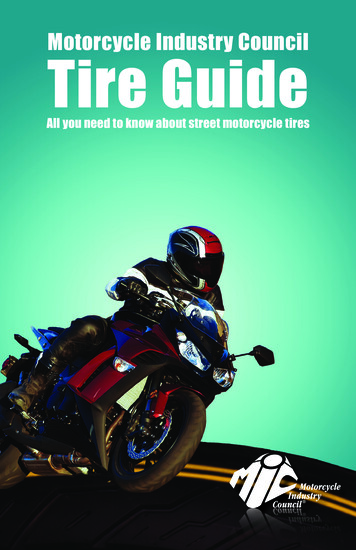
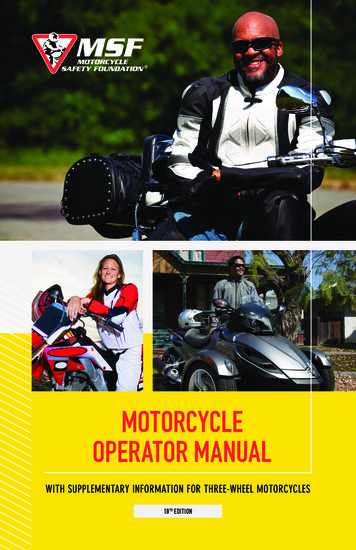
![Motorcycle Mechanic [MM] - CTEVT](/img/5/motorcycle-20-20mechanic-2010.jpg)

